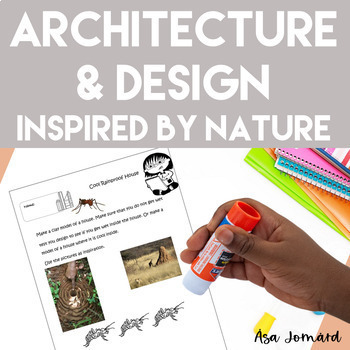Architecture & Design Activities | Biomimicry Design Project | Nonfiction
- PDF
- Easel Activity
- Easel Assessment
What educators are saying
Also included in
- This bundle contain ideas for engaging science project-based learning and includes two best/selling biomimicry resources. These units focus on robots, architecture and design. There are lesson plans that will guide you through the process of using biomimicry and steam activities. The aim is to igniPrice $9.00Original Price $13.00Save $4.00
- Your students will LOVE creating things and their inventiveness will flow as they explore the genius of nature. Using nature as inspiration is a powerful way to inspire your students to focus their attention on interesting aspects of the animal and plant world and to use these observations in creatiPrice $16.00Original Price $24.00Save $8.00
- This is a Science Bundle with both printable and digital formats. It includes everything you will need to have excellent and varied science and art activities available for your students. The aim is to ignite a love for question-asking and using biomimicry challenges in the classroom. Design inspirePrice $90.00Original Price $138.20Save $48.20
Description
Designing, building and making things capture children’s imagination. Explore the wonders of nature and architecture with these thought-provoking activities.
Engage students with captivating Architecture & Design Activities through this Biomimicry Design Project. This comprehensive resource fosters a deep understanding of nature-inspired design principles, integrating STEAM concepts and nonfiction learning. Perfect for promoting critical thinking and creativity, these activities are designed to inspire students to apply biomimicry to real-world architectural challenges.
How can you use a lotus flower to make a cosy reading nook? Why would you want to build a floating city? And how can an ant be used to build a huge garbage machine?
These activities are fun and engaging. And great brain workout!
This resource has been prepared so that your students can use it on digital devices. I have selected suitable slides for you, you need to insert text boxes and you can also add instructions for your students. There is also a short assessment with a couple of questions.
Contact me at maliasa@live.com if you have any questions, thanks.
Please click the PREVIEW button above to get an idea of everything included.
This inviting Architecture & Design package contains:
1. Introduction to biomimicry and using prior knowledge
2. Smart cities
3. Floating city
4. Reading or relaxing nook
5. Describe a honeycomb
6. Skyscrapers
6. Draw a house plan
7. Acrostic poem
8. Imagination challenge snails
9. Design a house inspired by shells and snails
10. Futuristic car
11. Story writing - futuristic car
12. Dinosaur bridge
13. Garbage machine
14. Cool rainproof house
15. Song about ants
16. Build a treehouse
17. Green living house
18. What have I learned?
19. How to use biomimicry in the classroom
20. Links and book tips.
21. Three posters
Leaving feedback when you purchase a resource earns you points toward FREE TPT purchases. I love that feedback!
Also, Follow Me and be notified when new products are uploaded. New products are always 50% off for the first 72 hours they are posted.
Want a resource about designing robots? Check out Project based learning: Robots - STEAM, Biomimicry and Soft Robots: Project Based Learning - STEAM, Biomimicry
You may also like Project Based Learning: Robot & Architecture, Design Bundle, STEAM, Biomimicry
Reviews of other Think Dive - Sparking Children's Thinkibility products:
Project based learning: Bats, STEAM, Biomimicry
"This product is absolutely the favorite one I have purchased all fall! I love the information that is provided about bats - just enough to intrigue and encourage higher level thinking. There are graphic organizers, worksheets, and subtle suggestions to help young learners perform at their best! And best of all, it stretches their creativity! Thanks for such an amazing resource!"
Project based learning: Mammals, Reptiles & Amphibians - STEAM, Biomimicry, NGSS
"Used this for a Kindergarten STEAM club unit and it was a hit!"
Why am I qualified to write these biomimicry resources? I was a member of BEN - Biomimicry Education Network - and a curator of educational resources at BEN. I am the author of the book Biomimicry with Theo & Tuva: Nature spotting inspires wild ideas. In 2015, I completed a course in Biomimicry: A Sustainable Design Methodology at Minneapolis College of Art and Design. I took part in the Biomimicry Design Challenge in 2021.
Product Format:
• This download is a PDF and is formatted in US Letter size. If you would prefer an alternate sizing, A4 size or spelling (colour vs color etc.), please leave me a note in the ‘ask a question section of my store'.
#biomimicry #biomimicrydesignproject #animals #nature #design #architecture #steam #stem #NGSS #sparkingchildrensthinkibility #thinkdive #asajomard #tpt #projectbasedlearning #digitalactivities









